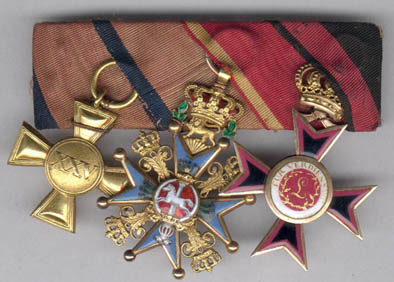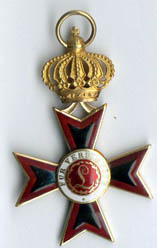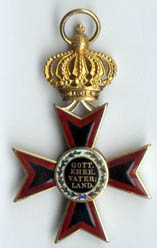|
One of the rarest Knights Crosses
regarding imperial German orders is the knights cross of
the Hessian Ludwig Order. From its issue date on, two
different classes were awarded, the knights cross 1st
class and the knights cross 2nd class. 1912 the knights
cross 1st class becomes the so called honor cross, a pin
back decoration. The knights cross 2nd class becomes the
"normal" knights cross.
The "Hessische Staatshandbuch"
1909/10 issue lists the following actual bearers:
|
Class |
Grand Cross |
Commander Cross
1st Class |
Commander Cross
2nd Class |
Knights Cross
1st Class |
Knights Cross
2nd Class |
golden
Medal |
silver
Medal |
|
Number |
14 |
- |
5 |
9 |
14 |
1 |
2 |
See the following decorations:
|
Knights cross 1st class awarded
December 19, 1841, to the later
Colonel Bernhard von Linsingen. This extremely
early piece is made from red gold. The red cross arm
frame is painted onto the black base enamel and
glazed for protection. The inscription of the
medallion is made of gold foil in a plastic way and
glazed also. A typical example for the workmanship
at the early 19th century. |
 |
|
See to the right the avers and
reverse of a knights cross 1st class made approx.
1880. This piece, as well as the above decoration,
is made in perfect workmanship for its time. The
cross body is made from red gold, too. The crown
however shows a typical two color work. Made from
red gold certain areas of the crown were etched to
take away the red coloring cooper proportion. |
  |
|
Here is an extremely rare example
of the last type of a "normal" knights cross made in
1918, only. This piece is made from gilt silver, but
regarding the ranking value of this particular order
in an extremely well manner. |
  |
© A. Schulze Ising, XI/99
|





